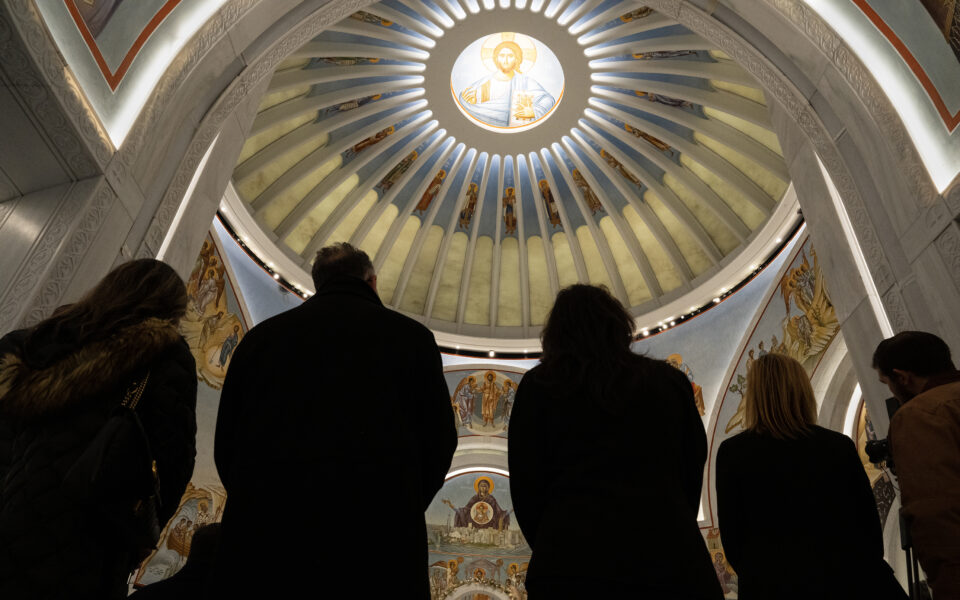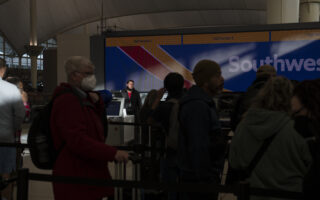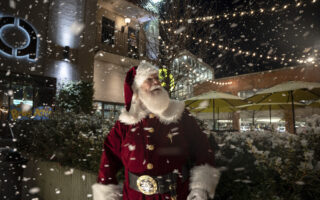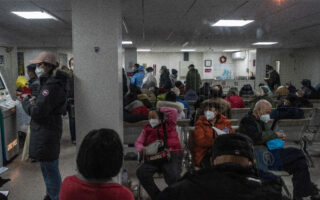A humble sanctuary reborn in grandeur

NEW YORK – Olga Pavlakos grew up going to St Nicholas Greek Orthodox Church in Manhattan. She was baptized there. Her parents were married there. She has memories of her father, who worked in restaurants, volunteering there on Sundays, and of celebrating Epiphany every January, when parishioners would walk to the Hudson River, toss a gold cross into the frigid water and watch divers plunge in to retrieve it.
“St Nicholas has been part of my family my whole life,” Pavlakos, a lawyer, said.
Her connection to St Nicholas can be traced to her grandparents, who left Greece in the early 1900s and settled in lower Manhattan, then a bustling immigrant community. Residents there scraped together money and bought a tavern on Cedar Street that they converted to a place of worship, eventually adding a bell at the top.
These original parishioners, who had arrived by boat, named their church after the patron saint of seafarers: a saint who fed the hungry, clothed the needy and inspired the character of Santa Claus.
As the decades passed and the modest buildings of the immigrant enclave gave way to the World Trade Center and other steel and glass towers of the financial district, many of the parishioners moved to other boroughs and beyond. But St Nicholas managed to stay put. That is, until September 11, 2001. The tiny church was obliterated during the terrorist attacks.
Twenty-one long and difficult years later, St Nicholas has reopened. But it is no longer a humble church, exclusively for its parishioners. Its mission is larger, as is its splendor.
St Nicholas Greek Orthodox Church & National Shrine, as it’s now called, has become a destination for all. It offers a bereavement center that will serve as a place for meditation and prayer for people of any faith. The structure itself cost $85 million and features white marble imported from the same quarry that provided stone for the Parthenon. The interior is decorated with icons hand-painted by a monk in Greece. The building sits proudly on an elevated plaza called Liberty Park, which overlooks the pools of the 9/11 Memorial. Its translucent dome glows at night.
More high-profile than the original saloon with a bell, the new church is a prominent expression of Orthodox Christianity in the city, and it is a source of great pride for the Greek American community.
For the few remaining longtime parishioners of St Nicholas, there is relief that their beloved church has finally reopened. But now, their intimate community hub is a global destination, and some wonder about the future of their once tight-knit parish.
St Nicholas has been recast as a national shrine memorializing the nearly 3,000 people who lost their lives 21 years ago. It is expected to attract a steady stream of tourists; an app offering an audio tour narrated by George Stephanopoulos is in the works.
‘A responsibility to bear witness to the lives lost’
In the aftermath of September 11, the 70 or so families of St Nicholas wanted to rebuild their church on the same small plot of land they had always owned. Regina Katopodis remembers driving her father, president of the parish council, from their home in Brooklyn to the site, where he would join the parish priest, the Rev John D. Romas, to sift through the rubble in search of any remnant that might be rescued. (Fortunately, no one was in the building during the attacks.)
The parishioners held monthly meetings. They organized fundraisers, including a cruise around Manhattan that passed Ellis Island, where their ancestors had once arrived from Greece.
But rebuilding in lower Manhattan after September 11 was no simple matter, given the jigsaw puzzle of projects that the Port Authority of New York and New Jersey, which had owned the World Trade Center, sought to piece together there. So the Greek Orthodox Archdiocese of America, which is based in New York, stepped in to take charge.
St Nicholas had been the only house of worship destroyed in the terrorist attacks, and church officials decided that it should be rebuilt as a spiritual refuge for all visitors to the World Trade Center area – perhaps a surprising stance for the Greek Orthodox Church, which represents only about 0.5% of the Christian population in the United States and has a decidedly conservative bent.
“It could not be what it was,” said the Rev Alexander Karloutsos, a former archdiocese official who was intimately involved in the rebuilding. “It was transfigured at that moment of death. We have a responsibility to bear witness to the lives lost”
Because of the ambitious scope of the project, the future of the church was largely out of parishioners’ hands, said Katopodis, an owner of Pi Bakerie, which serves up spanakopita and other Greek specialties a few blocks from St Nicholas.
“We had to step aside for a while,” she said.
Romas relocated to Saints Constantine and Helen Greek Orthodox Cathedral in Brooklyn, followed by several congregants, including Katopodis.
After years of political wrangling, stop-and-go negotiations and litigation, a land-swap agreement was finalized. The Port Authority would fold the church’s lot into surrounding property it controlled and build a secure facility for vehicles entering the area. In exchange, the church would get a spot atop the facility and slightly east of its original location, on the corner of Greenwich and Liberty streets.
The church would not only gain a more prominent address, it would also get an entire new look.
Santiago Calatrava, the Spanish-born architect who designed the modern, birdlike train station and shopping mall nearby known as the Oculus, sketched out a plan for a 12,000-square-foot domed structure with four corner towers, drawing inspiration from Byzantine art and architecture. When illuminated from inside at night, the dome would shine “like a candle,” he said.
But as the years went by and office towers went up on the trade center site, the 9/11 Memorial opened and tourists flocked to the area to pay their respects, the church project languished.
Construction did not begin until 2015, by which time costs, originally estimated to be $20 million, had skyrocketed. The archdiocese fell behind on payments. Skanska USA, the construction company, walked off the job. A fiscal scandal at the archdiocese led to multiple investigations and a leadership shake-up.
For more than two years, the concrete shell for the building sat there, an embarrassment for the archdiocese, which represents 550 parishes around the country and over 1 million members, many of whom had donated to the rebuilding effort.
“We lost credibility,” Karloutsos said.
In 2019 a group of wealthy Greek Americans got together to restart the project and push it over the finish line. The Friends of Saint Nicholas, as the group is called – including John Catsimatidis, the billionaire owner of the Gristedes supermarkets and onetime Republican candidate for mayor – raised the remainder of the money and kept tabs on construction.
Skanska got back to work. Marble quarried in Greece was honed and fused with glass in Germany and Austria, and then assembled into sections in Minnesota, before arriving in New York. The icons – painted by a master iconographer at a monastery in Mount Athos onto pieces of canvas sized to fit niches in the church’s interior – began arriving in diplomatic pouches.
The icons are everywhere in the new church. One near its entrance shows Ecumenical Patriarch Bartholomew I of Constantinople, the spiritual leader of the world’s Orthodox Christians, presenting a model of the church to St Nicholas. Another, behind the altar, depicts the Virgin Mother cradling Manhattan in her arms. Other panels include scenes from September 11, like the burning twin towers and some of the firefighters and police officers who died in the rescue effort, which the iconographer, known as Father Lukas, painted from photographs.
Before the opening of St Nicholas this month, Lukas flew to New York. He climbed up on the scaffolding and painted directly on the dome’s interior, embellishing the areas around the prophets.
Rebuilding the parish
Romas did not live to see St Nicholas reopen. Nor did the fathers of Pavlakos or Katopodis. Peter Zaharatos’ parents didn’t make it either.
“Half the parishioners from before 2001 are gone,” said Zaharatos, an architectural designer whose father, a furniture-maker and contractor, had helped renovate the old church in 1989.
Now that the church has been rebuilt, there is the question of rebuilding the parish, one with congregants who will show up week after week, not just drop-by visitors.
Lower Manhattan’s continued evolution holds promise on this front. The area has become more of a 24/7 neighborhood, with many more residential buildings. Already St Nicholas is being booked for baptisms and weddings. But it remains to be seen whether the people reserving dates will join the church or simply make use of its pristine, photogenic setting.
The Rev. Andreas Vithoulkas, a former chancellor of the archdiocese, has been appointed the new presiding priest. He plans “to not only minister to the Greek Orthodox faithful,” he said, but open the institution up to the rest of the world, in an attempt to “make this more of an ecumenical parish.”
Father Andreas, as he is known, has an assistant. There is also an office manager, a facility manager and a cantor.
Some Friends of Saint Nicholas members will become trustees of the church, according to Michael Psaros, the group’s chairman. The organization raised more than $5 million above what was needed to complete the church, and the money will go into an endowment to pay for security and building maintenance.
In a speech at the consecration of St Nicholas in July, Psaros predicted that it would attract more visitors than any other Greek Orthodox house of worship in the world.
In a nod to the more intimate days of the church, Zaharatos, Katopodis and Pavlakos all sit on the parish council, along with new members who include businesspeople and leaders of Greek institutions. The council has begun to make decisions about how things are going to be done in the new building – where the stand holding the icon of St Nicholas should be placed, for instance.
But other decisions have been made for them. At the old church, parishioners would show up before the feast day to clean, starting on the ground floor, with its ad hoc décor and dark-wood pews, and ending on the third floor, where everyone gathered after services for coffee, cake and announcements. St Nicholas has a cleaning service now.
On December 6 the church had its first regular liturgy service, held, appropriately enough, on the Feast Day of St Nicholas. It was packed. Pavlakos hung out in one of the candle rooms, tossing the melted-down ones into a cardboard box.
“My dad, when he was alive, used to do that,” she said. “He was in charge of the candles and the finances.”
Zaharatos was there, too. At one point, he stood near the church entrance, speaking about his family’s ties to St Nicholas.
While the new building was under construction, he had written his father’s name on a concrete pillar, now hidden under marble.
“I know it’s there. It means a lot to me,” he said.
“The church connects me to my parents in a powerful way,” he added. “It doesn’t look anything like it was, but I feel them here with me.”
This article originally appeared in The New York Times.






